
Maritime Trail offers divers much to see
HOMESTEAD, Fla.— At Biscayne National Park, hurricanes can actually be a good thing, at least for the park’s Maritime Heritage Trail.
A bit of stormy weather can lead to a shift in the sands and that can uncover long lost shipwrecks.
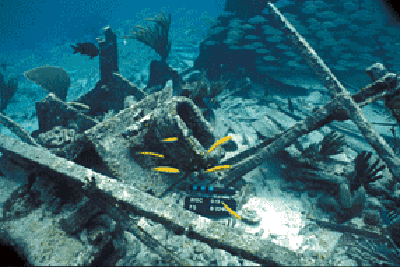 |
A mast base of the Mandalay (Photo courtesy of the National Park Service). |
Since its conception in 2005, the trail has added shipwreck sites each year. Last year, two of the sites on the trail were opened and today there are six: the Arratoon Apcar, Erl King, Alicia, Lugano, Mandalay and an unnamed 19th Century wooden sailing ship.
“We probably find a new shipwreck site about once a year,” said Brenda Lanzendorf, archaeologist and cultural resources manager for Biscayne National Park.
The discontinuous underwater trail is located in the eastern boundary of Biscayne National Park. Its northernmost shipwreck site is at Fowey Rocks lighthouse and the southernmost site is on the southern tip of Long Reef. The sites are currently accessible for self-guided tours, but park officials anticipate the trail will be open for guided tours early in 2008.
“As with any recreational venture on the water, [visitors should] make sure that they follow safe boating practices and that people are good swimmers,” said Lanzendorf, who’s been at the park for 10 years.
The idea for the underwater trail was a cooperative concept by Biscayne’s park staff to create an exhibit to teach park visitors about shipwrecks in addition to an exciting underwater experience.
“We thought the American public could help us protect the sites more if they were aware of these resources and what they can tell us,” said Lanzendorf.
| Brenda Lanzendorf is Biscayne National Park’s sole marine archaeologist, responsible for finding and studying wrecks in an area larger than Singapore (Photo courtesy of Jacqueline Carini). |
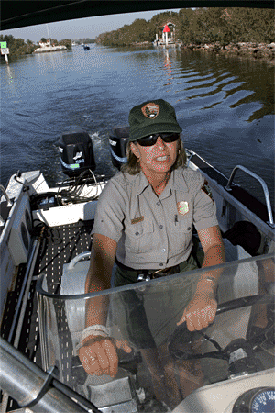 |
A few months after receiving a $40,000 grant from the South Florida National Park Trust for the project, the field work began. Marine biologists and archaeologists were brought in to help with the research and underwater mapping.
Lanzendorf is the sole underwater archaeologist at Biscayne, so if anybody knows anything about the trail, she does. Just mention the trail and she’s full of excitement and energy, which you wouldn’t expect from someone who’s responsible for finding and studying wrecks in an area larger than Singapore all by herself.
It’s not surprising that a large portion of the project’s grant was allocated to compensating volunteers who helped research and map the trail, but Lanzendorf says she could always use more help.
“I need volunteers,” she said exhaling after a laugh.
Preparing the sites for public viewing is a lot of work. It includes mapping the sites, installing mooring buoys to protect the sites from anchor damage and producing waterproof site cards.
Some of the shipwrecks on the trail have been in Biscayne’s water for hundreds of years. So these historic artifacts are filled with information about the people and machinery from their respective eras and regions.
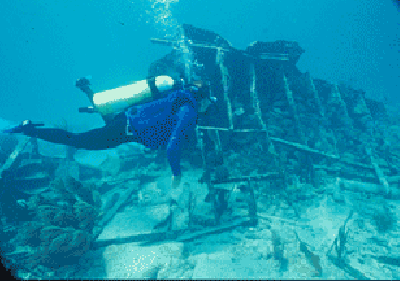 |
A diver on the site of the Mandalay (Photo courtesy of the National Park Service). |
Sergio Martinez, a ranger at BNP, discourages people from having preconceived notions about what they’re going to find when they dive down to the shipwrecks. He knows, because he was expecting to find a fully intact vessel when he dove down to view the Lugano.
“It wasn’t what I expected,” he admitted.
Martinez quickly realized the importance of all the remains, despite the fact that some of them are meager compared to theatrical presentations of shipwrecks. The relics that have remained over the years have withstood water decay and shifting sands with the decomposing process. Taking this in mind, Martinez says he was impressed; which brings about some worry for divers taking their own boats out.
“We hope they don’t take anything or move anything,” he said.
Therefore the park has to consider the potential hazards that loom when they open these relics up to the public. One of the primary concerns was anchor damage. So the park invested in mooring buoys for boaters visiting the sites on the trail. These buoys run in the hundreds of dollars as far as cost is concerned, but they prevent detrimental anchor damage to the shipwrecks.
Three of the six sites on the trail (Lugano, Mandalay, and the 19th Century sailing ship) have mooring buoys already; the others are expected to have them early in 2008.
Park officials have a philosophy they’ve incorporated to discourage divers from taking souvenirs from the sites.
| Proper mooring techniques ensure safety and protect the coral reefs at Biscayne National Park (Photo courtesy of the National Park Service). |
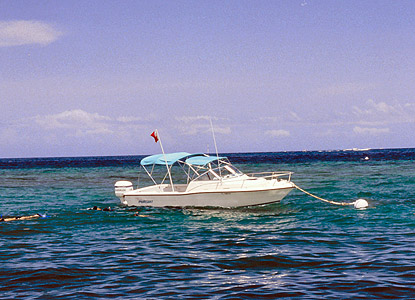 |
“We encourage people to take only photographs and leave only bubbles,” Lanzendorf explained.
The Mandalay and the 19th Century wooden sailing ship are in shallower areas where they can be viewed by snorkelers, but the others are best for divers. Kids are also welcomed. But all divers, young and old, need to be licensed.
“If it’s your first time going diving don’t go to a very deep site, stay in shallow water,” said Martinez.
The park is also putting the finishing touches on waterproof trail cards that will provide pertinent information about the individual sites, including historical facts and research, safety tips and site highlights.
“Hopefully one day we’ll have them available on the web site,” said Lanzendorf.
Once the cards are completed and the remaining mooring buoys are installed the trail will officially be opened. After that, plans are in the works to add sites from the Dry Tortugas National Park, located about 60 miles west of Key West, to the trail.
“Our hope is to merge the appropriate sites from both parks to provide the maximum number of shipwreck site experiences to visitors when they’re visiting parks in South Florida,” said Lanzendorf.
| The remains of the Arvatoon Apcar in the waters of Biscayne National Park (Photo courtesy of National Park Service). |
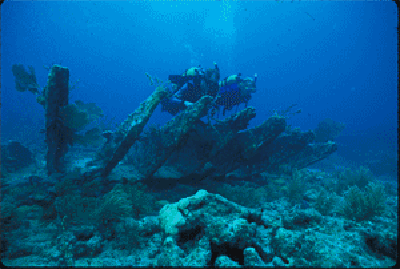 |
For more information about the Maritime Heritage Trail, visit http://www.nps.gov/bisc/historyculture/maritime-heritage-trail.htm or call the Dante Fascell Visitor Center at 305-230-7275 to speak with a ranger. Maps of Biscayne National Park and its shipwrecks can be viewed at http://www.nps.gov/bisc/planyourvisit/maps.htm .
If You Go
- Boaters need to bring their own snorkel and scuba equipment for the historic diving sites. The park does not rent gear to visitors for self-guided tours.
- Instructions on how to use a mooring buoy can be found at:
http://www.nps.gov/bisc/planyourvisit/mooring-buoys.htm - Mooring Buoy locations can be found at:
http://www.nps.gov/bisc/planyourvisit/mooring-buoy-locations.htm.

Comments are Closed